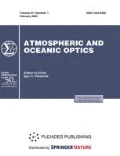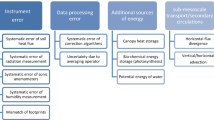Abstract
The process of the formation of a plume of NO2 emitted into the atmosphere by a point source is considered. A new technique is suggested for retrieving NO2 distribution fields in the troposphere from GSA Resource-P satellite data with the use of mathematical simulation. The functional form of the model is determined, which agrees in complexity with the amount of available experimental information; the values of the model parameters are found. The emission power is calculated. The reliability of the simulation results is estimated from the comparison of the calculations with the experimental distribution of the altitude-integratal amount of NO2 in air depending on the horizontal coordinates.



Similar content being viewed by others
REFERENCES
N. A. Ponomarev, N. F. Elanskii, A. A. Kirsanov, O. V. Postylyakov, A. N. Borovskii, and Ya. M. Verevkin, “Application of atmospheric chemical transport models to validation of pollutant emissions in Moscow,” Atmos. Ocean. Opt. 33 (4), 362–371 (2020).
A. Jericevic, L. Kraljevic, B. Grisogono, H. Fagerli, and Z. Vecenaj, “Parameterization of vertical diffusion and the atmospheric boundary layer height determination in the EMEP model,” Atmos. Chem. Phys., No. 10, 341–364 (2010).
J. J. P. Kuenen, A. J. H. Visschedijk, and M. Jozwicka, “Denier Van Der Gon H.A.C. TNOMACC_II emission inventory; a multi-year (2003–2009) consistent high-resolution European emission inventory for air quality modeling,” Atmos. Chem. Phys., No. 14, 10963–10976 (2014).
N. F. Elansky, “Air quality and CO emissions in the Moscow megacity,” Urban Clim. 8, 42–56 (2014).
Directive 2008/1/ES of the European Parliament and of the Council of 15 January 2008 concerning integrated pollution prevention and control. https://eur-lex.europa.eu/legal-content/EN/TXT/?uri=celex:32008L0001. Cited January 16, 2020.
Directive 2001/80/EC of the European Parliament and of the Council of 23 October 2001 on the limitation of emissions of certain pollutants into the air from large combustion plants. https://eur-lex.europa.eu/legal-content/EN/ TXT/?uri=CELEX%3A32001L0080. Cited January 16, 2020.
GOST 17.2.3.02-78. Nature protection. Atmosphere. Regulations for establishing permissible emissions of noxious pollutants from industrial enterprises. http://www.ekan.ru/sites/docs/GOST-17-2-3-02-78.pdf. Cited January 16, 2020.
Convention on long-range transboundary air pollution, Geneva, 13 November 1979. https://treaties.un.org/ Pages/ViewDetails.aspx?src=IND&mtdsg_no=XXVII-1&chapter =27&clang=_en. Cited January 16, 2020.
T. M. Butler, M. G. Lawrence, B. R. Gurjar, J. Van Aardenne, M. Schultz, and J. Lelieveld, “The representation of emissions from megacities in global emission inventories,” Atmos. Environ. 42 (4), 703–719 (2008).
B. R. Gurjar, T. M. Butler, M. G. Lawrence, and J. Lelieveld, “Evaluation of emissions and air qualities in megacities,” Atmos. Environ. 42 (7), 1593–1606 (2008).
N. F. Elansky, O. V. Lavrova, A. I. Skorokhod, and I. B. Belikov, “Trace gases in the atmosphere over Russian cities,” Atmos. Environ. 143, 108–119 (2016).
Resurs-P. http://russianspacesystems.ru/bussines/dzz/ orbitalnaya-gruppirovka-ka-dzz/resurs-p/. Cited January 16, 2020.
O. V. Postylyakov, A. N. Borovski, and A. A. Makarenkov, “First experiment on retrieval of tropospheric NO2 over polluted areas with 2.4-km spatial resolution basing on satellite spectral measurements,” Proc. SPIE—Int. Soc. Opt. Eng. 10466, 104 662 (2017).
O. V. Postylyakov, A. N. Borovski, N. F. Elansky, and M. A. Davydova, “Preliminary validation of high-detailed GSA/RESURS-P tropospheric NO2 maps with alternative satellite measurements and transport simulations,” Proc. SPIE—Int. Soc. Opt. Eng. 11152, 106–112 (2019).
Hysplit. www.ready.noaa.gov/HYSPLIT.php. Cited January 16, 2020.
Silam. http://silam.fmi.fi/index.html. Cited January 16, 2020.
M. A. Davydova, N. F. Elanskii, and S. A. Zakharova, “New approach to the problem of retrieval of the vertical coefficient of turbulent diffusion in the atmospheric boundary layer,” Dokl. Akad. Nauk. 2020 (in print).
Y. V. Mukhartova, M. A. Davydova, N. F. Elansky, O. V. Postylyakov, S. A. Zakharova, and A. N. Borovski, “On application of nonlinear reaction-diffusion-advection models to simulation of transport of chemically-active impurities,” Proc. SPIE—Int. Soc. Opt. Eng. 1157, 111570 (2019).
Funding
The study was carried out under the financial support of the Russian Foundation for Basic Research (project no. 18-29-10 080).
Author information
Authors and Affiliations
Corresponding authors
Ethics declarations
The authors declare that they have no conflict of interest.
Rights and permissions
About this article
Cite this article
Tikhonov, N.A., Zakharova, S.A. & Davydova, M.A. Simulation of the Dynamics of an NO2 Plume from a Point Source. Atmos Ocean Opt 34, 45–49 (2021). https://doi.org/10.1134/S1024856021010115
Received:
Revised:
Accepted:
Published:
Issue Date:
DOI: https://doi.org/10.1134/S1024856021010115




